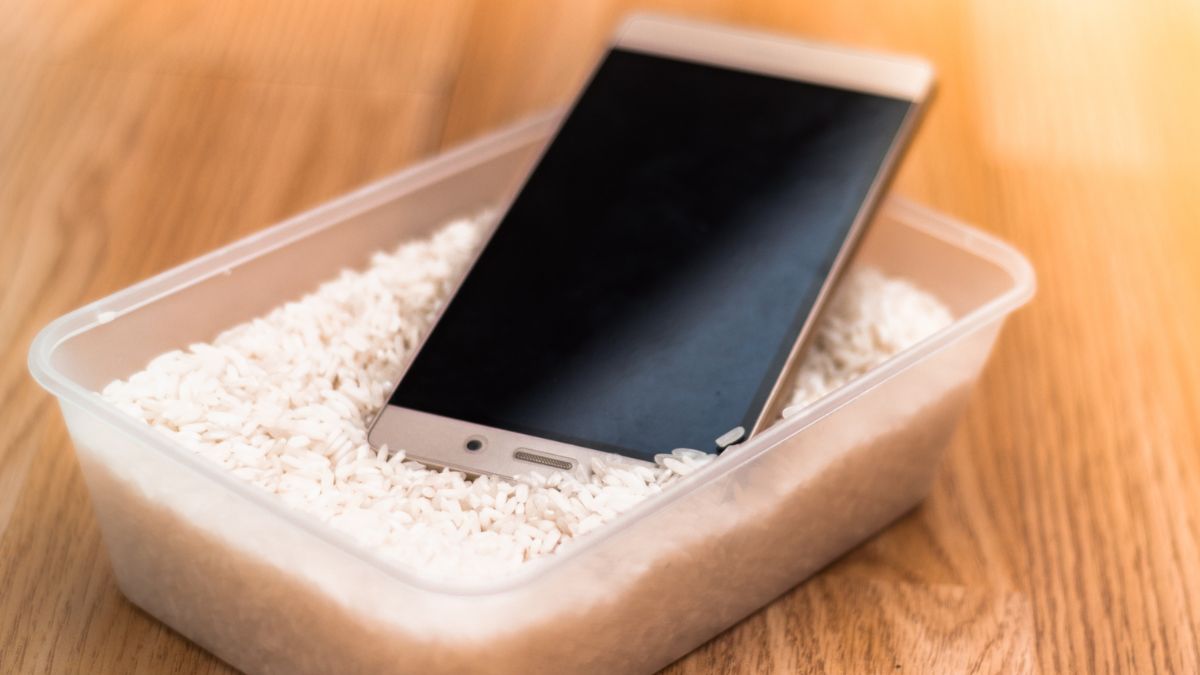Whether inadvertent or not, getting liquid spilled over your phone is almost certainly one of those panic moments you don’t want to have. But if your phone falls into a pool or gets a cup of coffee splashed on it, when is it too late to put your phone in rice?
Speed is key when trying to save a phone from water damage, so you’ll want to dry it off and then get it into uncooked rice as soon as possible, ideally sealing the container. After a minimum of 24 hours, you can check to see if it worked.
Let’s look at how rice can help with a phone, the best methods to do it, and things to avoid when trying to dry your phone out. We’ll also consider some alternatives to rice that may work better, and some that could cause further damage.
How Quickly Do You Need to Put Your Phone in Rice?
You should get the phone out of the water source and into the rice as quickly as possible. The quicker you do this, the less chance the water has to wreak havoc on the internals, and the higher chance that the rice can draw water out of the internals.
If your phone has been exposed to water high in salt, such as ocean water, then you should endeavor to get it in rice even quicker than if it were usual tap water. Similarly, if a liquid that is high in sugar is spilled on the phone, then it should be quickly removed and put in the rice.
Uncooked rice acts as a desiccant, a substance that helps absorb and thus dry out your phone’s internals.
First, you should retrieve the phone from the water source and do a quick dab with a towel or other object to dry it as much as possible, removing the battery, SIM card and internal SD card and case if possible.
Shake the phone vigorously to further dislodge any water and then get a container which will enable the phone to be completely covered in rice, such as a large bowl or a tall glass.
Place some uncooked rice in, then the phone, then fill up the container so that the device is covered.
Water damage will never be covered by any warranty and the phone’s internals will have pads and sensors which will detect water and change color, meaning any technician who is mildly experienced will spot this immediately.
The patches will be white when no water damage is detected, turning to red or pink once the water comes into contact with it.
This means that time is of the essence when getting it into rice, as if you can stop water seeping throughout the whole device, there is a higher chance that you won’t set off these sensors as the rice will arrest the water’s progress.
Can You Still Put Your Phone in Rice a Day Later?
If you’re trying to rescue a dead phone, you don’t really have many options and so trying rice a day later can’t hurt but your best chances of recovery involve getting it dry and into the rice as soon as possible.
Rice is a great staple to have in the house as it will keep for a long time and is an easy ingredient to cook up and add to almost any meal. It also means you’ll have some handy in case you need to do some emergency phone saving.
The drying process can be done for up to two days so having a whole day of your phone sitting with water on the electronics is not ideal but it may still be able to be salvaged.
How to Know It’s Too Late to Put Your Phone in Rice?
If the phone’s not turning on or it turns off when exposed to water, it’s likely that the damage was permanent and so may not be worth trying to dry it out, but either way, you shouldn’t be attempting to charge the phone until you have dried it out for one full day.
Once the phone has been completely submerged in water for anything longer than an instant, your chances of recovery are low. If your phone has a degree of water resistance, or is hermetically sealed, it may last longer, but generally, speed is key.
But as putting your phone in rice really only costs you the amount of rice and your time, and it could help the phone recover back to almost brand new condition, it’s worth a shot.
If you can open the phone up and see that all the water sensors have been triggered, then there’s probably not much point in trying to dry it out, but the time it takes you to do this, let alone get the right tools to do so, would be better spent getting the device into rice.
How Long to Keep Phone in Rice?
You should try and keep the phone completely covered in dry, uncooked rice for at least 24 hours and it doesn’t hurt to go up to 36 hours or beyond.
The absorption and drying process is passive and so can take some time to fully get all the moisture out. If you’re noticing any dampness in the rice, it’s worth immediately getting rid of it and replacing it with fresh, dry rice.
Generally, you’ll want to make sure it is a sealed container, such as a Tupperware container or even a Ziploc bag that is shut tight.
It is not a bad idea to use some tape to cover up holes such as the headphone jack, charging port and other openings to prevent small grains from entering.
If possible, you’ll want to leave it in rice at least overnight, and ideally, you will want to stretch it to 48 hours or longer if you can go without the phone for that long.
Prematurely charging or trying to turn it on before it has fully dried could lead to further damage, so be patient and give it time to dry.
Does Putting a Phone in Rice Really Work?
Rice can work as a way to help pull moisture out of a phone but it is by no means a guaranteed fix, as water damage can cause instant failure of an electronic device that no amount of drying can reverse.
Rice can only hold a small bit of moisture per grain, and so the overall capacity to pull large amounts of water out is going to be limited.
Moisture is going to get trapped in all sorts of small nooks and crannies within the phone, making retrieval even by very absorbent rice a tall order.
However, there have been many people who have reported success with the method, as well as seemingly just as many people who report it was no good. As very few people ever recover a phone that has been submerged in water for a few minutes, this is to be expected.
Even people who transport electronics around in moisture heavy areas, like in humid climates, report that using rice or silica packets in their bags goes a long way to keeping equipment like cameras and other sensitive electronics running in good condition for longer.
It is not uncommon for a phone seemingly to have recovered after a short stint in rice, only for it to die a few days later. This is because some of the remaining water inside the phone has been allowed to cause further damage, which could have been avoided.
The water or salt in the water can build up corrosion inside the phone over time, meaning that while you thought your quick acting with drying saved the handset, in fact, you just had a dead handset walking and didn’t realize it.
Since the iPhone 7 launched in 2015, every device has come with an IP67 water resistance certification, meaning it can survive for about 30 minutes being fully submerged in water that is one meter or less.
While this doesn’t sound like much, it does allow the occasional spill or moisture build up while still allowing the phone to perform.
In the end, it’s probably the case that the phone would’ve survived even without the rice treatment, but that doesn’t mean you should skip this step given the lack of good alternatives.
How to Dry out a Phone Without Rice?
Silica Gel is one of the best ways to remove moisture from something, and is what they are designed for. That is why you will find them inside products like foodstuffs, shoeboxes and anything else where mold or water damage could be an issue.
While you can purchase them in bulk from online marketplaces like Amazon, you will be surprised at how many you will come across in your everyday life that you will just bin without considering it.
Instead, get a sealable container and plop any silica packets into it and you’ll have a decent collection in no time, enabling you to use them to surround your phone in should you find yourself in the unfortunate situation of needing to dry it out.
Cat litter is another option, although the loose nature and small granules may not result in the best results. However, it will dry things out but is not designed for this type of use case.
Unused tea bags can absorb a very small amount of moisture and this will work in a pinch, but you’re best off sourcing some rice or gel packets.
Isopropyl alcohol, sometimes referred to as rubbing alcohol, is fine to use in small amounts and go for around 70% concentration. 90% will be too high, and can be used sparingly if that’s all you have.
One of the properties of isopropyl alcohol is that it will naturally evaporate, and so it can help clean and dry your phone but it is more useful as a sterilizing agent rather than as a desiccant.
Using a heat source is generally a bad idea, as it is going to affect any plastics and the internals in a negative way.
So it’s best to avoid direct heat sources like a hairdryer, heater, or even natural sources like leaving it out in the sun. While this may reduce water content inside the device, it will likely cause other problems like permanent damage to the internals including the battery.
A simple pedestal fan blowing air across a phone can be one of the more effective drying agents, and doesn’t have the big downside of causing further issues such as corrosion or putting small grains of rice into a port that you’ll never be able to dig out again.
Other alternatives can be to put a phone in the freezer for a few days but this should be an absolute last resort. Not only can the freezing process cause more moisture to accumulate inside, but the cold can outright kill the internals.


